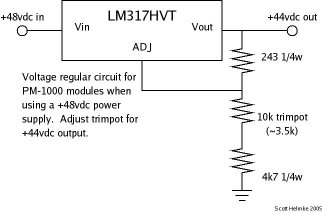Phantom Power, is it really always +48 ?
Phantom Power, is it really always +48 ?
I've noticed that many mics can run on variable phantom power and I've seen a few pieces of gear use less voltage for phantom power. I wondered if some would like to chime in after actually measureing the phantom power on their devices.
This leads to another question. What is the most popular component for achieving clean 48 volts? My mouser search produced this unit.
TL2575HV
http://www.mouser.com/search/ProductDet ... 5HV-ADJIKV
Other wise the good old LM317 +37 seems to be adequate for many mics.
http://www.mouser.com/search/ProductDet ... -LM317AHVT
Aside from 'headroom' that I don't think anybody could hear what would be the problem with using 37v instead of 48v?
This leads to another question. What is the most popular component for achieving clean 48 volts? My mouser search produced this unit.
TL2575HV
http://www.mouser.com/search/ProductDet ... 5HV-ADJIKV
Other wise the good old LM317 +37 seems to be adequate for many mics.
http://www.mouser.com/search/ProductDet ... -LM317AHVT
Aside from 'headroom' that I don't think anybody could hear what would be the problem with using 37v instead of 48v?
I design the Chadwick Series for Krank amps but I'm really getting interested in mic pres. Love tape op. Great vibe and not a lot of flamming that I noticed.
- Scodiddly
- speech impediment
- Posts: 4012
- Joined: Wed Dec 10, 2003 6:38 am
- Location: Mundelein, IL, USA
- Contact:
Most mics are OK all the way down to 12 volts. So a lot of installed/institutional/portable stuff uses lower voltages, maybe 15 or 18 volts. A lot of USB/firewire mic preamps use a lower voltage as well.
I've done a basic LM317HVT ("high voltage" version of LM317) circuit which does OK, assuming you've got a source of greater-than 48 volts to start with. Ignore the text, it's from a different topic.

I've done a basic LM317HVT ("high voltage" version of LM317) circuit which does OK, assuming you've got a source of greater-than 48 volts to start with. Ignore the text, it's from a different topic.

- Roboburger
- buyin' gear
- Posts: 536
- Joined: Wed May 07, 2003 7:44 am
- Location: Williamstown, MA
The typically excellent results I get from a Peavey TMP are only lowered by the crappy onboard 24 volt phatom power that some of my mics just don't like, like my Alesis Groove Tubes AM-11. I use my patchbay to let me power phantom from my board, and just never ever push in the 24v button on the TMP.
Audio Engineer Euphemism for going number two: "Rollin' off the Low End."
-
Andy Peters
- re-cappin' neve
- Posts: 602
- Joined: Mon Mar 12, 2007 8:45 pm
- Location: Sunny Tucson
Re: Phantom Power, is it really always +48 ?
The actual phantom power spec (an AES or IEC spec; I forget which) is 44 V to 52 V through 6.81K resistors to pins 2 and 3 of the XLR connector. At the nominal 48 V, you've got a maximum current-source capability of 7 mA in each pin when the pins are grounded. Practically, the most current you can get is 5 mA per pin or 10 mA total.chadwick wrote:I've noticed that many mics can run on variable phantom power and I've seen a few pieces of gear use less voltage for phantom power. I wondered if some would like to chime in after actually measureing the phantom power on their devices.
This is a step-down switcher, meaning you'll need to provide a DC voltage above 48 V as its input.This leads to another question. What is the most popular component for achieving clean 48 volts? My mouser search produced this unit.
TL2575HV
If you've never built a switch-mode power supply, you probably shouldn't try to use this part.
I think you read that data sheet incorrectly -- there's no such thing as an "LM317 +37." The 317 is an adjustable regulator, so you need to RTFDS to determine how to set the output voltage. You still need to provide an input voltage greater than the output voltage plus the regulator drop-out (so figure you need > 52 V). You don't need the HV part as the input-to-output differential won't exceed the standard 317's 40V spec.Other wise the good old LM317 +37 seems to be adequate for many mics.
http://www.mouser.com/search/ProductDet ... -LM317AHVT
Aside from 'headroom' that I don't think anybody could hear what would be the problem with using 37v instead of 48v?
You can get your input voltage from an 18V wall-wart and a voltage tripler. See Rick Chinn's article.
Good luck,
-a
"On the internet, nobody can hear you mix a band."
ya, cool.
Go figure, I linked to the lm317 and I didn?t even realize it was the high voltage version. Cool.
Sounds pretty easy to get 48 and not settle for 37 though I think you could get away with it.
Sounds pretty easy to get 48 and not settle for 37 though I think you could get away with it.
I design the Chadwick Series for Krank amps but I'm really getting interested in mic pres. Love tape op. Great vibe and not a lot of flamming that I noticed.
www.organissimo.org
organissimo - Dedicated (new CD)
"This shitty room is making your next hit record, bitch!"
organissimo - Dedicated (new CD)
"This shitty room is making your next hit record, bitch!"
Hmmmmmm.....
OK, the "correct phantom voltage design" is this:
1. A 48 VDC supply (well filtered!) as a source.
2. 6k8 resistors from the +48 VDC source onto pins 2 and 3 of the incoming XLR mic connector.
3. XLR pin 1 is -48V/common/ground
Anything else is NON-standard. 24V or 12V is non-standard. Some mics work at 12 or 24 volts. Neumans will NOT.
Bri
OK, the "correct phantom voltage design" is this:
1. A 48 VDC supply (well filtered!) as a source.
2. 6k8 resistors from the +48 VDC source onto pins 2 and 3 of the incoming XLR mic connector.
3. XLR pin 1 is -48V/common/ground
Anything else is NON-standard. 24V or 12V is non-standard. Some mics work at 12 or 24 volts. Neumans will NOT.
Bri
-
Andy Peters
- re-cappin' neve
- Posts: 602
- Joined: Mon Mar 12, 2007 8:45 pm
- Location: Sunny Tucson
phantom
Not -48V!brianroth wrote:3. XLR pin 1 is -48V/common/ground
It's 0V -- the circuit common (ground/return).
-a
"On the internet, nobody can hear you mix a band."
OK...that's what I meant...the "minus" side of the 48V power supply, and NOT a ground-referenced -48 VDC rail. <g>
Phantom powering circuitry is well-referenced from many sources. Odd-ball 12 and 24 and whatever voltages are total bull. Stick with the standards, as I attempted to describe. Anything else is bound to fail in the long run.
Example: I recently was sent a "rackup" for repairs that included a 10K resistor in series with the 48V rail that in-turn fed the 6k8 resistors at the mic inputs. That was a No-Go for a U-87.
Bri
Phantom powering circuitry is well-referenced from many sources. Odd-ball 12 and 24 and whatever voltages are total bull. Stick with the standards, as I attempted to describe. Anything else is bound to fail in the long run.
Example: I recently was sent a "rackup" for repairs that included a 10K resistor in series with the 48V rail that in-turn fed the 6k8 resistors at the mic inputs. That was a No-Go for a U-87.
Bri
My long-time friend Rick Chinn has posted some very useful articles on the subject of phantom powering:
http://www.uneeda-audio.com/#phantom
Bri
http://www.uneeda-audio.com/#phantom
Bri
Who is online
Users browsing this forum: No registered users and 43 guests
